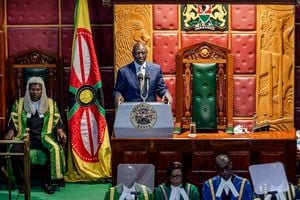Road to COP27: Localise the mitigation measures

A man shows carcasses of his cows that died due to drought in Dabel village, Marsabit County. The worrying state of climate in Kenya, as in the rest of the globe, is captured in the recently launched State of the Climate in Africa 2020.
A friend of mine bought four acres of land at Buyuha, on the shores of Lake Victoria in Busia County, in the early 1980s. Come 2022, it had reduced to two and a half acres, the rest having been ‘swallowed’ by the lake. He wanted to sell part of it but the measurements shown on the title deed and the actual size were different.
At the neighbouring Mutarahunga beach, a family has a dispute over their land measurements; it is no longer enough to share after they sold parts of it and the lake gnawed at the remainder.
Welcome to the world of climate change, where deadly heatwaves, floods, wildfires, prolonged droughts, declining crop yields and loss of livestock are wreaking havoc with increasing intensity. Its economic and social effects are gradually coming home to roost and county governments must prioritise mitigation measures. The loss of massive lands to flooding mean displacement of families and food insecurity and increased family disputes.
Key policy issue
Climate change is a key developmental and policy issue yet only the national government seems keen on dealing with it. Little is happening at the county level. While a few counties have enacted climate change laws, it is at the national level where we see administrative codes, public awareness, knowledge transfer and capacity building with some success.
The 27th UN Climate Change Conference of the Parties (COP27) comes up in Egypt in November, and big delegations will present country papers without explicitly talking about the in-country gaps.
While Kenya has invested a lot in mitigation and adaptation interventions, much more need be done. The discussion has largely remained in towns yet local communities bear the brunt of climate change effects. Farming is not productive anymore and food security is threatened.
In recognising the devastating impact of climate change, the government initiated interventions such as the enacting of the Climate Change Act, 2016, amending of the Environmental Management and Co-ordination Act, 1999 and development of the National Adaptation Action Plan (2013-17). There are also sectorial initiatives aimed at strengthening the resilience of communities.
Grim picture
The worrying state of climate in Kenya, as in the rest of the globe, is captured in the recently launched State of the Climate in Africa 2020, which paints a grim picture of the continent. As we make policies at the national level, we need to build the capacity of counties to deal with climate change. Counties must prioritise climate change in their planning and allocate sufficient resources to it.
At the seventh Devolution Conference, in Makueni, that focused on unlocking the full potential of climate action during and after the Covid-19 pandemic, governors discussed and shared mitigation strategy on climate change. This was good. Now, both the national and county governments should localise measures to combat the effects of climate change through deliberate and well-funded interventions. We must cushion communities against them.
Mr Bwire is the director of media, training and development at Media Council of Kenya. [email protected].





